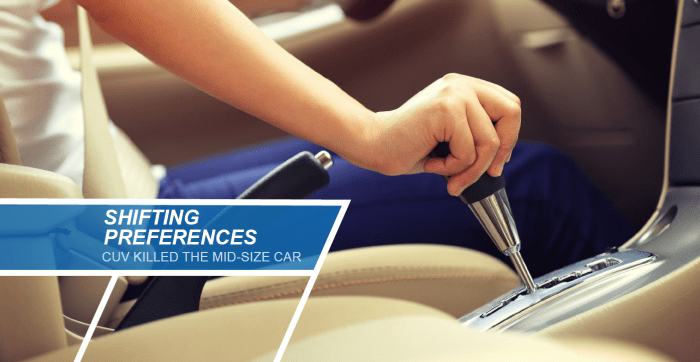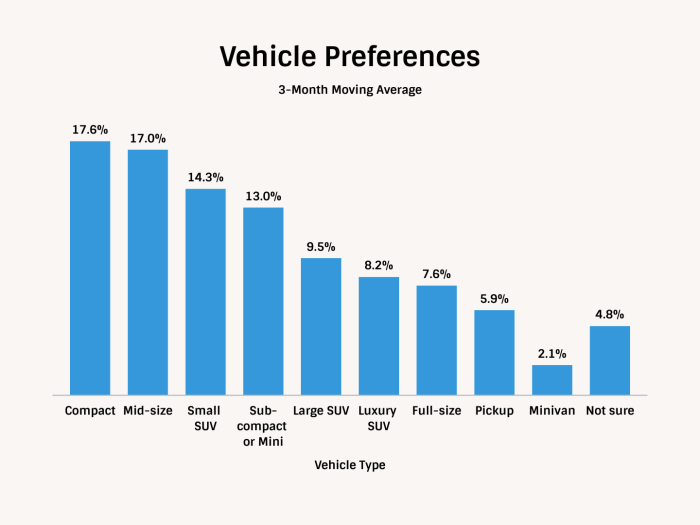Shifting Consumer Preferences

The automotive industry is experiencing a period of significant transformation, driven by evolving consumer preferences. Buyers are increasingly discerning, demanding vehicles that align with their lifestyles, values, and priorities. This shift necessitates a dynamic approach from manufacturers, requiring them to adapt rapidly to remain competitive.
Consumer preferences are changing across several key dimensions, impacting vehicle design, production, and marketing strategies. The traditional dominance of sedans is waning, replaced by a surge in demand for SUVs and crossovers. This reflects a societal shift towards larger, more versatile vehicles, suitable for families and active lifestyles. Simultaneously, growing environmental awareness and government regulations are propelling the adoption of electric vehicles (EVs) and hybrids, creating a new landscape for the industry.
Evolving Vehicle Type Preferences
The rise of SUVs and crossovers is undeniable. Their spacious interiors, higher driving positions, and perceived safety advantages have made them highly attractive to a broad range of consumers. This trend is further amplified by the increasing popularity of compact SUVs, offering a blend of practicality and fuel efficiency. Meanwhile, the electric vehicle (EV) market is experiencing exponential growth, fueled by technological advancements, decreasing battery costs, and increasing government incentives.
Hybrid vehicles continue to offer a bridge between traditional gasoline engines and fully electric powertrains, catering to consumers seeking a balance between fuel efficiency and performance.
Demographic Impact on Automotive Demand
Changing demographics significantly influence automotive demand. Millennials and Gen Z, known for their tech-savviness and environmental consciousness, are driving the demand for EVs and vehicles equipped with advanced technology features. Older generations, while often prioritizing reliability and safety, are also increasingly open to exploring fuel-efficient options and incorporating technology into their vehicles. Income levels also play a crucial role; higher-income consumers often opt for luxury vehicles with advanced features, while budget-conscious buyers focus on affordability and fuel efficiency.
Influence of Consumer Priorities on Car Design
Consumer priorities regarding fuel efficiency, safety features, and technology are fundamentally reshaping car design. Manufacturers are investing heavily in lightweight materials, advanced engine technologies, and aerodynamic designs to improve fuel economy. Safety features, such as advanced driver-assistance systems (ADAS), are becoming increasingly standard, reflecting consumer demand for enhanced safety and security. Technology integration, including infotainment systems, connectivity features, and autonomous driving capabilities, is rapidly transforming the driving experience, becoming a key differentiator in the marketplace.
Consumer Preferences Across Demographics
The following table illustrates how consumer preferences vary across different age groups and income levels. Note that these are generalizations, and individual preferences can vary widely.
| Vehicle Type | Age Group | Income Level | Top 3 Preferences |
|---|---|---|---|
| SUV/Crossover | 35-54 | $75,000 – $150,000 | Safety, Space, Fuel Efficiency |
| Electric Vehicle | 25-34 | $50,000 – $75,000 | Technology, Environmental Friendliness, Performance |
| Sedan | 55+ | <$50,000 | Reliability, Fuel Efficiency, Ease of Driving |
| Hybrid | 35-54 | $50,000 – $75,000 | Fuel Efficiency, Reliability, Technology |
Technological Advancements
The automotive industry’s response to evolving consumer preferences is significantly shaped by rapid technological advancements. These advancements are not merely incremental improvements; they represent a fundamental shift in how vehicles are designed, manufactured, and experienced. Consumers are increasingly demanding vehicles that are safer, more connected, and offer a more personalized driving experience.
This demand is driving innovation across several key areas, fundamentally altering the automotive landscape and reshaping consumer expectations. The integration of advanced technologies is no longer a luxury feature but a crucial factor influencing purchase decisions.
Advanced Driver-Assistance Systems (ADAS) and Consumer Choice
The proliferation of ADAS features, such as adaptive cruise control, lane keeping assist, automatic emergency braking, and blind-spot monitoring, has dramatically altered consumer preferences. These systems enhance safety and driver convenience, leading to a significant increase in demand for vehicles equipped with these technologies. Consumers are willing to pay a premium for the added safety and peace of mind provided by ADAS, making them a key selling point for manufacturers.
For example, the Tesla Autopilot system, while controversial at times, significantly contributes to the desirability of Tesla vehicles.
Connectivity Features and Consumer Demand
Connectivity is another critical aspect driving consumer demand. Modern infotainment systems, featuring large touchscreens, smartphone integration (Apple CarPlay and Android Auto), navigation systems, and over-the-air updates, are becoming standard features even in budget-friendly vehicles. The seamless integration of smartphones and the ability to access entertainment and information on the go are major factors influencing purchase decisions, particularly among younger buyers.
The intuitive and user-friendly interfaces of these systems enhance the overall driving experience, making the vehicle more than just transportation; it becomes a connected hub for daily life.
Autonomous Driving Technology and Changing Expectations
Autonomous driving technology is still in its nascent stages, but it is already reshaping consumer expectations. While fully autonomous vehicles are not yet widely available, features like adaptive cruise control and lane centering assist provide a glimpse into the future of driving. The promise of self-driving cars, offering increased safety, reduced traffic congestion, and improved fuel efficiency, is significantly influencing consumer attitudes.
Companies like Waymo and Cruise are actively testing and deploying autonomous vehicles, gradually shifting consumer expectations towards a future where autonomous driving is commonplace. This anticipation, even without widespread availability, creates a demand for vehicles with progressively advanced autonomous features.
Impact of Technological Features on Vehicle Pricing
| Feature | Price Impact | Consumer Demand | Justification |
|---|---|---|---|
| Advanced Driver-Assistance Systems (ADAS) Suite | Medium to High | High | Increased safety and convenience features command higher prices but are highly sought after. |
| High-Resolution Infotainment System with Navigation | Medium | High | Improved user experience and connectivity features are increasingly expected, even in mid-range vehicles. |
| Smartphone Integration (Apple CarPlay/Android Auto) | Low | High | Becoming a standard feature; consumers expect seamless smartphone integration. |
| Partial Autonomous Driving Capabilities (e.g., Adaptive Cruise Control, Lane Keeping Assist) | Medium | Medium to High | Growing demand, but full self-driving capabilities are still largely unavailable and expensive. |
| Premium Sound System | Low to Medium | Medium | Desirable, but not a necessity for most buyers; impacts price less significantly. |
Marketing and Sales Strategies

The automotive industry’s marketing and sales strategies are undergoing a significant transformation to keep pace with the evolving preferences and behaviors of digitally savvy consumers. This shift necessitates a move beyond traditional advertising methods towards a more integrated, data-driven approach that prioritizes personalization and digital engagement.The adaptation involves leveraging digital channels to reach target audiences effectively, utilizing data analytics to understand consumer preferences, and employing innovative technologies to enhance the customer experience.
This multifaceted approach is crucial for automotive manufacturers to remain competitive in today’s dynamic market.
Digital Marketing and Reaching Savvy Consumers
Automotive marketers are increasingly relying on digital channels to connect with consumers. This includes targeted online advertising campaigns across various platforms, search engine optimization () to improve website visibility, and the development of engaging digital content such as videos, interactive infographics, and virtual tours. For instance, many manufacturers now use programmatic advertising to precisely target specific demographics and interests on websites and social media, ensuring their marketing messages reach the most receptive audiences.
Email marketing remains a powerful tool, personalized to individual customer preferences based on browsing history and past interactions.
Personalized Marketing and Data Analytics
Personalized marketing is rapidly gaining traction in the automotive sector. Manufacturers collect and analyze vast amounts of data—from website interactions and social media activity to CRM data and purchase history—to create detailed customer profiles. This allows for targeted advertising, personalized recommendations, and customized offers. For example, a consumer who frequently searches for electric vehicles online might receive targeted ads showcasing the latest electric models, along with incentives and financing options specifically tailored to their needs.
This data-driven approach enhances customer engagement and leads to improved conversion rates.
The Role of Social Media and Online Platforms
Social media and online platforms have become crucial in shaping consumer perception and purchase decisions. Manufacturers use these channels to build brand awareness, engage with potential customers, and manage their online reputation. Social media campaigns, influencer marketing, and interactive content on platforms like YouTube and Instagram play a vital role in showcasing vehicle features, highlighting brand values, and generating excitement around new models.
For example, a successful social media campaign might involve user-generated content showcasing the versatility of a particular SUV model, creating a sense of community and positive brand association. Negative reviews or service issues can also quickly spread online, highlighting the importance of active social media monitoring and responsive customer service.
Virtual and Augmented Reality in the Automotive Industry
Virtual and augmented reality (VR/AR) technologies are transforming the customer experience. Manufacturers are leveraging these technologies to create immersive virtual showrooms, allowing potential buyers to explore vehicles in detail from the comfort of their homes.
Virtual Showroom Experience
A virtual showroom offers a realistic and engaging experience, replicating the feel of a physical dealership but with enhanced features. Users can navigate a 3D environment, exploring various vehicle models, customizing options (exterior color, interior trims, etc.), and even taking virtual test drives. Interactive elements allow users to open doors, examine interiors in detail, and access specifications and pricing information.
The experience can be tailored to individual preferences, with personalized recommendations based on past interactions and stated preferences. For example, a user interested in fuel efficiency might be presented with information about the vehicle’s MPG and hybrid options prominently displayed. The virtual showroom can also incorporate interactive elements such as 360° views of the vehicle’s exterior and interior, allowing for a comprehensive exploration without the need for a physical visit.
This enhances convenience and allows manufacturers to reach a wider audience, including those in remote areas or with limited mobility.